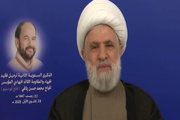Art is Love
By Mostafa Mousavi Sabet
The only art which is deeply intertwined with the literature and mysticism of the magical land of Iran is the art of miniature. In fact, no other art form has been able to illustrate the content and concept of the metaphors, similes and hyperbole of traditional Iranian literature as successfully as miniature. However, it should be mentioned that among the Iranian arts, calligraphy (such as nasta'liq) also has a prominent status in this regard. Some concepts of our traditional literature such as 'moon statue', 'eyebrow arc', and 'Narcissus's eye' can only be expressed through miniature.
Master Abbas Jamalpour calls the art of miniature Iran's national style of painting.
Jamalpour has spent about 48 years working in this field. He has also spent about 24 years researching and studying the relationships between painting and music, art and advertisement, art and politics, energy and the philosophy of art and literature.
Although he is quite proud of his nationality, he states, "I am always seeking ways to think and practice universally."
This artist, who considers himself to be a part of the universe, believes that when one thinks and practices based on this point of view, he will have better results.
It seems that this point of view is in contrast with the discussion which we had before the interview, in which he emphasized his Iranian nationality. He explained this contradiction, saying, "I have been raised in Iran's climate and atmosphere so I have a close relationship with it, but this does not mean that I should not have any connection with the world. The relationship between Iran and me is just like the kind of relationship a mother has with her child. A child loves his mother and respects her and since he respects the other mothers of the world, he never makes any inappropriate comment about them. According to the philosophy of the world, somehow all human beings have a bond and relationship with each other."
Generalizing Sa'di's poem saying 'Adam's progeny are all kin', Jamalpour adds that all of creation, including man, are interrelated and the fate of a being determines one's destiny. That is why suicide is forbidden and considered to be a major sin. In fact, man is a vital part of the earth. Therefore when one commits suicide, he creates deficiency, but as this world enjoys plurality, this deficiency remains unnoticed. But we should be aware that God has not created us in vain and our role is to behave in a way that brings happiness for ourselves and also to the soul of the world, too.
He believes that climate and geographical conditions have a significant effect on man. He said, "Life in any particular geographical location will establish its own specific accent, language, art and ideology. When the soil is examined, different elements and particles are found in it which contain positive and negative charges. The combination of these elements differs in various parts of the world. As a result, the same products have a different quality in various locations. For example, the lemons of Mazandaran differ from the lemons of Bam in Kerman. These differences can be observed in human beings, too. So the influential factors and also the influenced factors should be recognized. As we gain better knowledge and information about all of these issues, we will be able to tread the path easier."
Master Jamalpour is 69 years old. He has held exhibitions both in Iran and abroad and has also taken part in three miniature biennial exhibitions as a member of the jury. He was the secretary of the 5th Biennial Miniature Exhibition which was held in Tehran in early spring.
A number of foundations and organizations have held honorary ceremonies for this great miniaturist. The latest honorary ceremony was held by the Cultural Heritage Organization during Cultural Heritage Week.
Master Jamalpour is retired from the army. Once he was responsible for the designs made for the flags, signs and emblems and all artistic affairs of the army. He is also a talented musician. We were not surprised when he invited us to listen to a live piece of music.
Following is an exclusive interview with the artist.
Q: The arc of the eyebrows, the languidness of eyes, the stretch of the fingers and many other beautiful and attractive manifestations and even at times rather ugly ones which are not observed all together and in one place, are depicted in an exaggerated way in miniature. Perhaps this art intends to portray the ideal state of human beings. What is the source of this exaggeration?
A: Exaggeration is in the nature of art and can be revealed in two ways. At times it highlights and enlarges a fault and flaw to manifest its bitterness in the most prominent way and at times it highlights and enlarges a virtue and goodness in order to captivate and inspire our power and force. In this particular case I believe that if we increase the light of virtue, vice will automatically fade away.
In the literature of our country, exaggeration plays a significant role. For example in a poem, Ferdowsi speaks of Rakhsh, the horse of Rostam as:
Outline of an ant on a black carpet,
Clear in night from far apart.
One can usually not see an ant from one meter away, but in our literature an ant can be seen from a very great distance on a dark rug at nighttime! And this is very beautiful.
Exaggeration in artistic and literary works makes people have pleasant and nice beliefs about artists and literary men. In fact, they usually have a good picture of artists in their minds through their works, but they may change their minds when they meet them. Therefore, it is said, "Communicate with an artist's work, but not with he himself."
But our mysticism tells the artist to behave in such a way so as to create a unified effect, whether people meet him or communicate with his work. In Iranian literature, one can not achieve knowledge and wisdom through a scientific event alone, so Einstein will not be known through his law of relativity. But the personality of a mystic is revealed when he speaks. As a result a mystic seeks to turn everyone into a mystic. So, if we want to consider the real meaning and concept of 'art', then the artist should possess a pure soul, in such a way that communicating with him would be exactly like communicating with his artistic work.
Q: As you explained, each one of your works has a legend or anecdote from our classical literature and ancient cultural beliefs. How are the pictures portraying these legends developed?
A: The main and proper guidance exists in the soul of each artist, that is his sense and emotions. We see through the eyes, hear through the ears, then we evaluate, receive the beauties and transfer them to the brain. It is quite obvious that all of these issues depend on the state and health of the soul and the spirit.
The health of the spirit and the soul depends on four principles: nourishment, evacuation, purification and affection. Human beings should perceive all the beauty they observe with their eyes, but of course should not experience a sense of possession or transgress toward it. For example, when you observe a beautiful flower, there is no need to pick it up and place it on the collar of your coat. You can look at a beautiful building without buying it. The perception of beauty differs from possession and transgression.
One should listen to the best musical notes and pieces and speeches through the ears. Also, one should smell the best perfumes and fragrances through the nose and eat the best and healthiest foods through the mouth. The head functions as the commander. When the mind and brain is properly fed, it gives the right orders to all parts of the body. After that the evacuation occurs, which means that all the negative and unsuitable communications are disconnected and all of the waste is thrown away. In the third phase we have purification. When we empty the dustbin, some of the waste may still be in the bin and it may have an unpleasant smell, too. Therefore we wash the bin with water. In the fourth phase, where we have affection and purification, we gain it through art, love and kindness. The role of art becomes obvious and clear at this stage. The point is that good and healthy nourishment will automatically lead to evacuation. In this part, once again we face the same principle which we spoke about before: when you lead in light, darkness will automatically fade away.
Q: Most of the protagonists of your works are women. Is there any particular reason for this?
A: One should become familiar with women and get acquainted with them properly. Women play a significant role in creation. I believe that women are the greatest supporters and protectors of all societies. The tone of a woman's voice has a prominent role in the structure of personality, the treatment of sickness, affection and healing, the mental state and mood, soothing the spirit and finally guiding a man. The root of the problems is lack of perception and awareness. Men and women play complimentary roles. We even have two kinds of strings for musical instruments. Some of the strings have a feminine sound and some strings have a masculine sound.
One of the main points in understanding women is perceiving the role they play in the constancy of life. Art has four principles: deep awareness, creation, beauty and contemplation. Women are naturally more attuned to these things. Women are more sensitive and aware and they recognize a lie quite easily. Since women are more creative, they give birth to a live painting, music and architecture called a child. As she is more attractive, children are drawn towards their mother at home. But the main point is that humans are born in the lap of women and their identity is formed through a mother's affection, love and care. Therefore, women have a high and elevated position. If a society tends to move towards the desired and beneficial path, it must possess good mothers.
Q: You mentioned that your wife has passed away. How has your life changed as a result of this loss?
A: As a matter of fact, one realizes the value of something only when he loses it. I lived over forty years with my wife. Her absence in my life caused me to understand women more than ever and perceive their influence and effect on life and on the progress of humanity more than before.
Q: What is the status of the art of miniature in our country? When was the golden age of this art in Iran?
A: I believe that the art of miniature is improving in Iran. We must recognize the different forms of development and evolution. Progress and evolution is not limited to the technical methods used in a work. Other elements such as the number of people working in that particular field, their age, their personality and many other features make up the various dimensions of evolution. If we don't have any knowledge about the factors of change and alteration, then we can't make any judgement on them.
One of the aspects of this year's miniature exhibition, which I regarded to be quite important, was the large number of women taking part. While a total of 177 men participated in the exhibition, 261 women also took part, which is quite good news.
Literature has had the chance to flourish in our beloved Iran as a result of the freedom and independence it has enjoyed. So Iranian literature has become known all over the world. But painting and music have some limitations, though at times some of the limitations and boundaries seem quite necessary. The main distinction between art and other cultural phenomena is that art preserves its own qualities and characteristics. Our literature is in touch with the other manifestations and forms of art such as painting, music, and theater and has influenced their movement and development.
Islam made our literature immortal through its deep and original instructions from the Holy Qoran. Therefore, art means preservation. Though we have a lot of mosques in our country, the kind of art used in the Sheikh Lotfollah Mosque (located in the Naghsh-e Jahan Square in Isfahan) has been preserved in all eras. The Qoran is God's word. Still when this holy book is written by the best calligrapher, illuminated by the most expert illuminator and bound by the best book binder, it should either be put in a museum or, if it is kept at home, it should be kept just like things are kept in a museum. As you see, art can preserve things.
Q: Why do you consider the rise in the number of women miniaturists to be evolution and progress?
A: When women are drawn towards art, they eventually become familiar with the designs, the method of using colors and other artistic techniques. As a result, they will practice these principles at home, too. When this happens, all the members of the household will receive joyful energy.
We are born to create a positive and useful influence in the universe and we have to acquire the wisdom and knowledge needed for treading this path. One of the best ways to gain this knowledge is through art. Symphonies composed many years ago are still being performed in various places around the world and people enjoy listening to them. Therefore, we should consider the momentary, eventual and eternal effect of our deeds and works. All of the manifestations of love will be given an elevated rank.
This can be seen in nature, too. When you go to a flower garden, suddenly you realize that your spirits are raised. As a matter of fact, one of the functions of nature is to raise the spirit of humans.
Q: As you said, you spent some years of your life in the army. It seems that the army has a relatively lifeless and dull atmosphere, not at all in harmony with art.
A: In fact the manifestations of art are seen in the army more than in any other place. Painting, theater, cinema, and music are not considered to be art by themselves. Just as the fan, the lamp and the iron are not electricity; these are all manifestations of art, too. The only meaning of art is love. Art is love.
We should try to see what makes one put on a uniform despite all the responsibilities it entails. This is done because of love alone, and any deed which is done for love is art.
When a person who is in love rides a horse, though a pebble may be under the horse's hoof, the sound will be like a beautiful symphony to him. Therefore, love appears in various different forms. Love should be created in plentiful portions.
If a lifeless and dull atmosphere does not prevail in the army, serious and fundamental problems would occur. This is also true about the whole universe, too. If Hafez's poetry loses its versification, then his poetry will become meaningless.
Art which is truly love has a different kind of manifestation in the army. For example, the physical gestures in the army are all designed on the basis of artistic principles. When someone salutes his superior, on the surface it looks as if he does it for his rank. But in fact it shows a specific kind of artistic respect. I am quite ready to analyze all of the physical gestures of the army from an artistic point of view.
Of course the negative image of the army is a result of the historical background. An aggressive, mendacious and deceptive person is introduced as one of the members of the army. And since some of the staff accepts this view, they gradually change their attitudes and conform to this image.
Q: Elderly people are depicted often in your works. What is the status of the elderly in your works and in miniature in general?
A: I have a painting called 'The Component Waves in Evolutionary Symmetry'. In this work I have drawn a series of waves which gradually appear as an elderly person who is creating a woman. This woman is also seen at the top of the painting in a smaller scale, but the woman who is a creator in the main field of the painting, is gradually developing and compared to her small scale at the top of the painting, is becoming complete.
In Iranian mysticism elders play a prominent, determining and leading role. The great Iranian poet Mowlavi has expressed his views on elders in various poems. For example, in one of his poems he said:
"Let an elder lead you through the journey of life, otherwise the lack of experience makes this path dangerous and risky."
In relation to this view, people asked him about ways to find an experienced elder. Mowlavi responded, stating his major point as:
"O young men, the elder is manifested through your mind and thoughts, not by white hair and white beards."
When they told him that this experience is gained through the passage of time, he answered:
"This experience known as the elder is in truth your love, not your white hair. Many disappointed ones rescue their lives with love."

























Your Comment